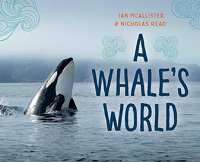| ________________
CM . . . . Volume XXIV Number 38. . . . June 1, 2018
excerpt:
Another title in the series “Great Bear Rainforest”, A Whale's World follows a pod of orcas as they hunt. Details are presented as seen by one orca until, with no hunting success, the pod moves on along the coast in search of elusive meals. These marine predators belong to a community of many other inhabitants, such as grizzlies, wolves, various fish, gulls, eagles, sea lions, sea urchins, that make up the wildlife population of this particular environment. The reader is given a peek into their habits, species relationships and roles in the ecosystem, such as how different fish eat each other, or how gulls drop clam shells to open them. Many themes emerge: life cycles, survival strategies (especially that not all hunts are successful), food chains, and adaptation. The writing is informative, using a simple straightforward style with richly detailed language to paint word-pictures for the target audience. Each new species is introduced with a kid-friendly comparison, such as "crayon-sized" sardines, harbour seals "as big as stuffed hockey bags" and sea urchins looking like "hedgehogs". However, a couple of assumptions have been made that might leave young readers puzzled. For instance, no specific location is given for the Great Bear Sea in the introduction or elsewhere. This may have happened because the book is part of a series, and, while one would benefit most by reading all the titles, each should be able to stand alone as well. With respect to facts, we learn that salmon "return to the forest's rivers when their time in the sea is done", but there is no mention of the exact reason (spawning). The Pacific octopus have "even been known to use primitive tools", but no example is given to clarify the statement of its intelligence for this age group. There is so much to engage young readers, though, that the curious will likely have enough information and motivation to question these points or investigate further. The large clear photos all meet the top quality now expected of the series. The subjects are all identified in the paragraphs that accompany each photo, with one exception: one wader (a dowitcher?) eating herring eggs is not named in the text. A Whale’s World adds another aspect to the interest in and understanding of this environment allowing the reader to see how each component of the community is integrated into the whole. Definitely worth adding to the collection for a complete picture. Highly Recommended. Gillian Richardson is a freelance writer living in BC
Next Review |
Table of Contents for This Issue
- June 1, 2018. |
